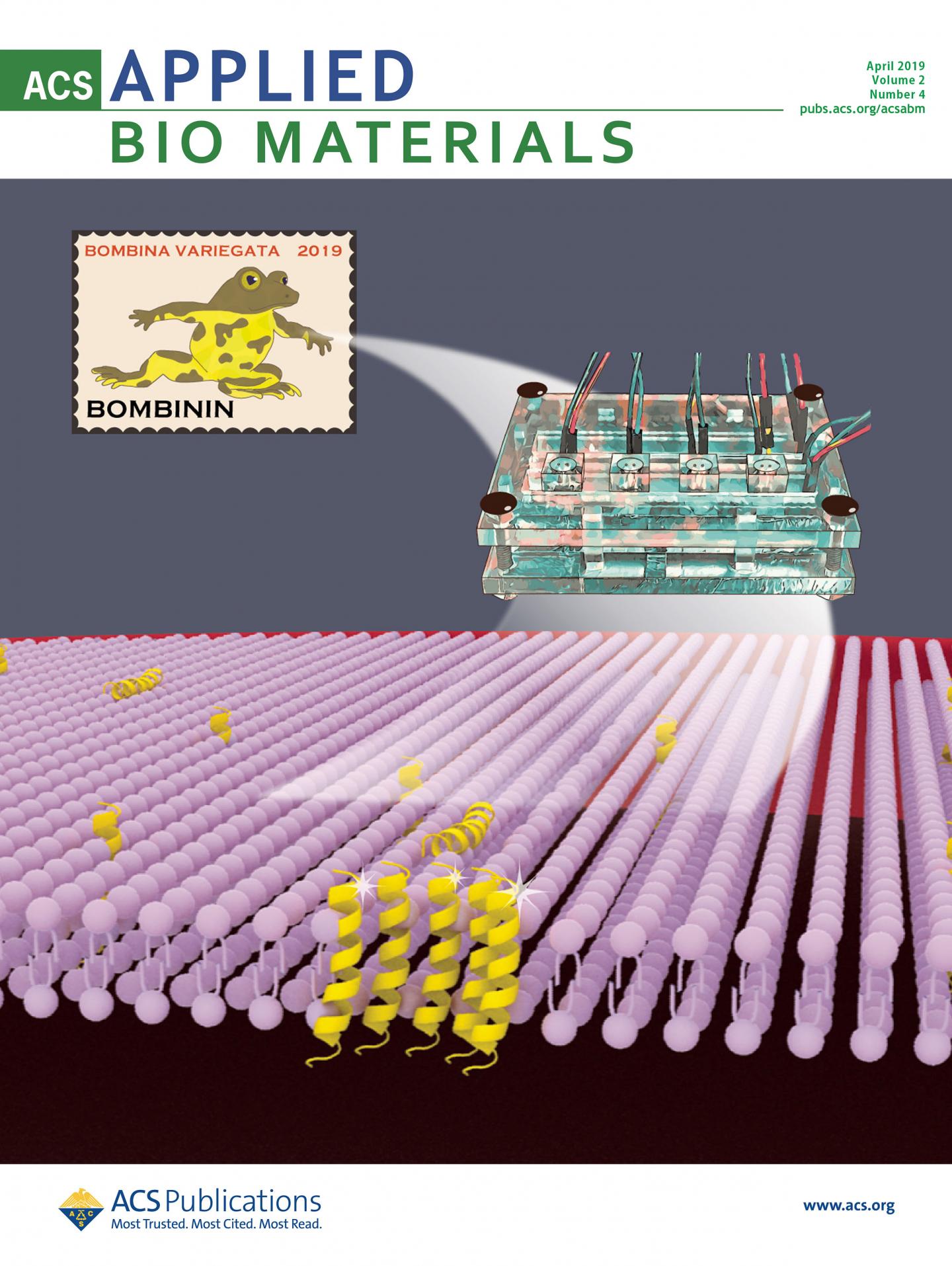
Credit: Figure adapted with permission from the front cover of ACS Appl. Bio Mater., 2019, 2 (4). Copyright © 2019 American Chemical Society
Japanese scientists including researchers at Tokyo University of Agriculture and Technology (TUAT) and Yokohama National University have identified the molecular mechanism that gives the skin secretions of a species of frog effective antimicrobial properties.
Their findings were published on February 20, 2019 in ACS Applied Bio Materials.
The Bombina variegata frog, also known as Yellow Bellied Toad, inhabits the forests, grasslands, wetland, and aquatic habitats across Central Europe. Their skin secretions contain antimicrobial agents – called Bominin H2 and H4 – that play a key role in protecting the species against infection.
Bombinin H2 and H4 are antimicrobial peptides (AMPs) – or host defense peptides – that play an important function in immune response. They have attracted attention for their ability to inhibit Leishmaniasis — a highly infectious and potentially fatal tropical disease that has affected an estimated 20 million people worldwide, with 1.3 million new cases and 20,000 to 30,000 deaths reported each year.
H4 is an isomer of H2 – they share the same formula but the atoms in the molecule are arranged differently – with H4 having a naturally occuring D-amino acid at the end of the molecular chain. In terms of its antimicrobial properties, H4 is more potent than H2, but until now, the reason has remained an unsolved biological mystery.
“D- and L-amino acids are mirror images of each other, and most amino acids in nature have L structure,” explains Ryuji Kawano, Associate Professor in the Department of Biotechnology and Life Science at TUAT and co-author of the study. “A few proteins are modified to have D-amino acids. The role of having D-amino acids is not fully understood in case of the frog.”
In order to gain a better understanding of the molecular mechanism that drives the antimicrobial activity of Bombinin H2 and H4 peptides and what makes H4 more effective than H2 in this regard, the authors conducted electrophysiological experiments on a lipid bilayer membrane that replicated the lipid membrane surrounding cells or microorganisms The results were then analyzed using existing AMP models to determine how efficient these antimicrobial peptides are at disrupting the cell membrane of microbes.
The team found that H2 and H4 peptides inhibit microbial activity by making holes in the cell membrane of microorganisms, causing ions to leak out of the cell, which ultimately kills them. The efficiency of this anti-microbial activity is affected by ion permeability (how fast ions leak out of the cell), the speed of pore formation, and the size of the pores formed.
The results indicate that the peptides’ ability to transform into another molecule with the same atomic composition but with atoms arranged differently facilitates faster pore formation. While H2 forms larger pores than H4, H4 forms pores more rapidly. A mixture of H2/H4, meanwhile, forms medium-sized pores at a slower rate than H4, but the presence of the D-amino acid enhances the binding affinity to the lipid membrane, thereby improving its disruptive abilities.
Think of it like a field of different sized pit traps; larger traps take longer to dig, but can trap more animals than a smaller pit. On the other hand, one can dig many smaller pits in the same time it takes to dig just a few large ones. Digging medium sized pit traps and adding bait or a lure that would attract animals to the pit, would be the most effective approach of all.
Unravelling the molecular mechanism that facilitates antimicrobial activity of these peptides can help us better understand how the defense system of the frog has evolved, and how this can be used to fight microbial infections of medical importance. According to Kawano, the ultimate goal is to use this mechanism to develop better antimicrobial agents, especially antimicrobial agents that are effective against antibiotic-resistant bacteria.
###
About Tokyo University of Agriculture and Technology (TUAT)
TUAT is a distinguished university in Japan dedicated to science and technology. TUAT focuses on agriculture and engineering that form the foundation of industry, and promotes education and research fields that incorporate them. Boasting a history of over 140 years since our founding in 1874, TUAT continues to boldly take on new challenges and steadily promote fields. With high ethics, TUAT fulfills social responsibility in the capacity of transmitting science and technology information towards the construction of a sustainable society where both human beings and nature can thrive in a symbiotic relationship. For more information, please visit http://www.
Original publication:
Yusuke Sekiya, Keisuke Shimizu, Yuki Kitahashi, Akifumi Ohyama, Izuru Kawamura, and Ryuji Kawano. ” Electrophysiological Analysis of Membrane Disruption by Bombinin and Its Isomer Using the Lipid Bilayer System”, ACS Appl. Bio Mater., 2019, 2 (4), pp 1542-1548, DOI: 10.1021/acsabm.8b00835
Contact:
Ryuji Kawano, Dr.,
Associate Professor,
Department of Biotechnology and Life Science,
Tokyo University of Agriculture and Technology.
Email: [email protected]
For more information about the Kawano laboratory, please visit http://web.
Media Contact
Yutaka Nibu, PhD
[email protected]
Related Journal Article
http://dx.



